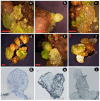Phenolic Exudation Control and Indirect Somatic Embryogenesis of Garlic-Fruit Tree (Malania oleifera Chun & S.K. Lee)-An Endangered Woody Tree Species of Southeastern Yunnan Province, China
- PMID: 40733422
- PMCID: PMC12299711
- DOI: 10.3390/plants14142186
Phenolic Exudation Control and Indirect Somatic Embryogenesis of Garlic-Fruit Tree (Malania oleifera Chun & S.K. Lee)-An Endangered Woody Tree Species of Southeastern Yunnan Province, China
Abstract
Malania oleifera Chun & S.K. Lee, an endemic monotypic species that belongs to the family Olacaceae, is under continuous pressure of decline owing to several ecological and physiological factors. The present study aimed to establish an efficient in vitro protocol for callus-mediated indirect somatic embryogenesis in M. oleifera by alleviating tissue browning. Internodes and leaves obtained from seedlings were used as explants. Antioxidant pre-treatment (ascorbic acid, AA) followed by different carbon sources (sucrose, maltose, glucose, and fructose) and plant growth regulators in various concentrations and combinations were employed in Woody Plant Medium (WPM) to alleviate explant browning and induce callus formation from the explants. AA pre-treatment and subsequent culture on maltose at a concentration of 116.8 mM were optimal for controlling phenolic exudation on >90% of both explants. The highest responses of 53.77% and 57.43% for embryogenic calli were induced from internode and leaf explants, respectively. The highest responses, 85.22% and 93.80%, were observed for somatic embryos that matured into the globular, heart-shaped and torpedo stages at different percentages on NAA 2.5 mg/L in combination with BA 1.0 mg/L for both explants. The matured somatic embryos were finally germinated at a maximum concentration of GA3, 2.0 mg/L. All plantlets were successfully hardened and acclimatized under culture room conditions and then transferred to the greenhouse. The current study suggests an efficient protocol for indirect somatic embryogenesis by alleviating phenolic exudation from the explants of M. oleifera. This first successful report of in vitro culture establishment in M. oleifera may offer an effective alternative measure to conserve this species and provide a system for analyzing bioactive chemicals and for use in the oil industry.
Keywords: Malania oleifera; carbon source; endemic tree; nervonic acid; phenolic exudation; reintroduction; somatic embryogenesis.
Conflict of interest statement
The authors declare that they have no conflict of interest.
Figures




Similar articles
-
First Report of Anthracnose on Camellia oleifera Caused by Colletotrichum fioriniae in Hunan, China.Plant Dis. 2025 Jul 6. doi: 10.1094/PDIS-01-25-0221-PDN. Online ahead of print. Plant Dis. 2025. PMID: 40619719
-
Direct somatic embryogenesis induction in Aspilia Africana (Pers.) C. D. Adams, and assessment of genetic homogeneity and physiology of regenerants.Sci Rep. 2025 Jul 30;15(1):27791. doi: 10.1038/s41598-025-13476-4. Sci Rep. 2025. PMID: 40739128 Free PMC article.
-
Sexual Harassment and Prevention Training.2024 Mar 29. In: StatPearls [Internet]. Treasure Island (FL): StatPearls Publishing; 2025 Jan–. 2024 Mar 29. In: StatPearls [Internet]. Treasure Island (FL): StatPearls Publishing; 2025 Jan–. PMID: 36508513 Free Books & Documents.
-
NTP Developmental and Reproductive Toxicity Technical Report on the Prenatal Development Studies of 2-((1-(4-Phenoxyphenoxy)propan-2-yl)oxy)pyridine (CASRN 95737-68-1) in Sprague Dawley (Hsd:Sprague Dawley® SD®) Rats and New Zealand White (Hra:NZW SPF) Rabbits: DART Report 07 [Internet].Research Triangle Park (NC): National Toxicology Program; 2022 Jan. Research Triangle Park (NC): National Toxicology Program; 2022 Jan. PMID: 35593777 Free Books & Documents. Review.
-
Levetiracetam add-on for drug-resistant focal epilepsy: an updated Cochrane Review.Cochrane Database Syst Rev. 2012 Sep 12;2012(9):CD001901. doi: 10.1002/14651858.CD001901.pub2. Cochrane Database Syst Rev. 2012. PMID: 22972056 Free PMC article.
References
-
- Ma B., Liang S., Zhao D., Xu A., Zhang K. Study on plants containing nervonic acid. Acta Bot. Boreali-Occident. Sin. 2004;24:2362–2365.
-
- Tang T.F., Liu X.M., Ling M., Lai F., Zhang L., Zhou Y.H., Sun R.R. Constituents of the essential oil and fatty acid from Malania oleifera. Ind. Crops Prod. 2013;43:1–5. doi: 10.1016/j.indcrop.2012.07.003. - DOI
LinkOut - more resources
Full Text Sources

